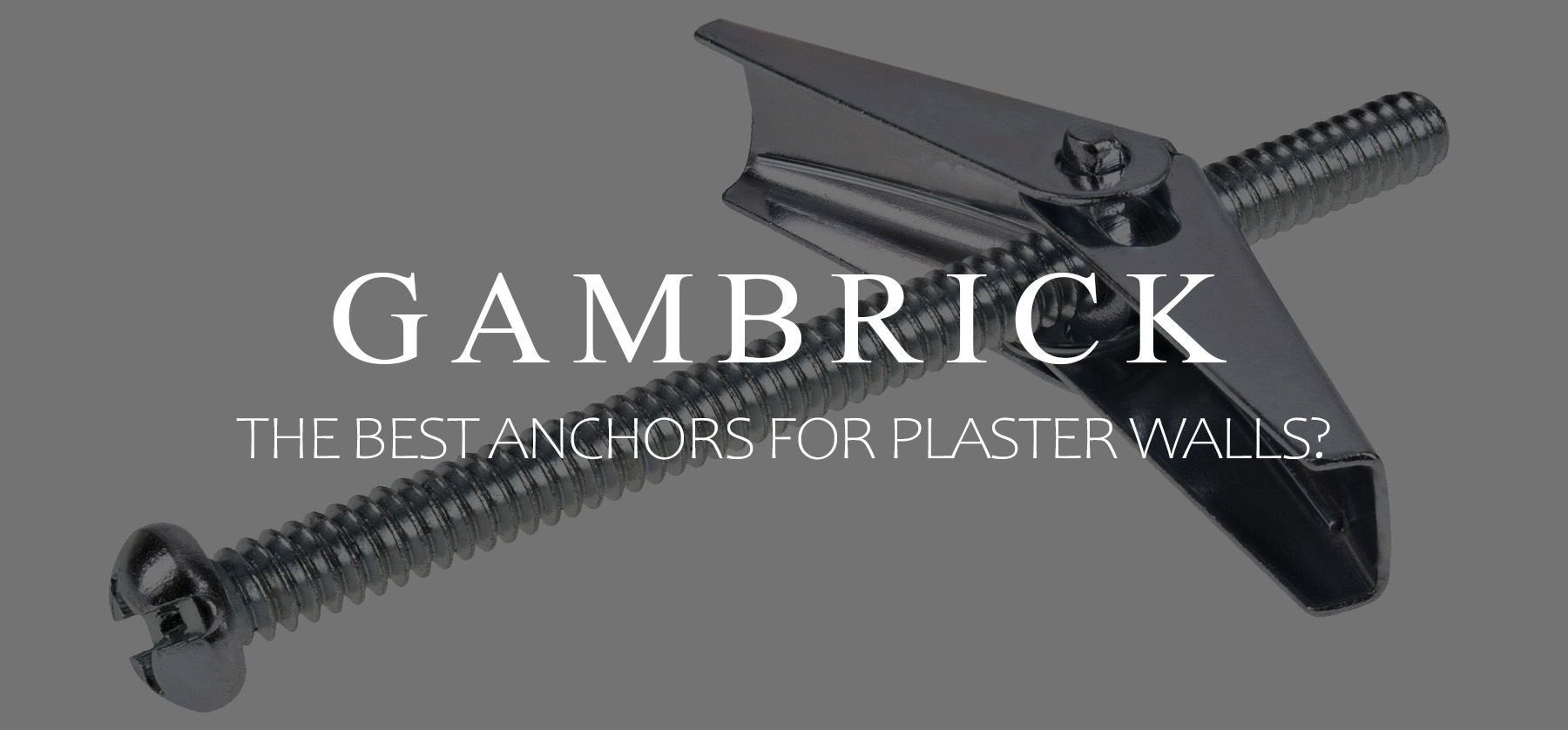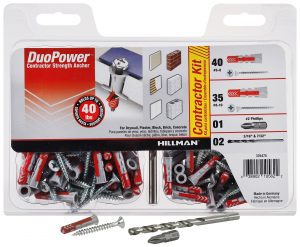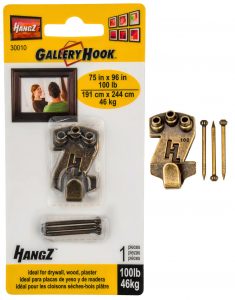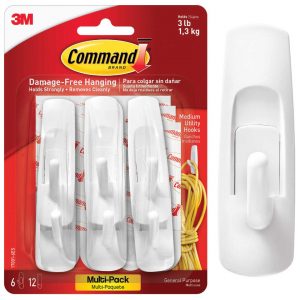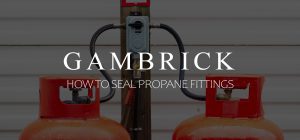The 5 Best Anchors For Plaster Walls
One of the best anchors for plaster walls is the Toggle Bolt which is also called a Butterfly Anchor. The toggle bolt inserts into a hollow wall through a small hole. Once fully inserted, it springs open to secure itself to the backside of the plaster. It’s then tightened by turning its shaft like a screw. Once the anchor springs open, its very hard to pull out and can hold a lot of weight.
The best anchors for plaster walls have a component which expands when the anchor is inserted into the hole. Plaster is very different from drywall and can support a lot of weight.
Plaster is a type of masonry made from cement, lime and sand mixed with water. So an anchor that’s rated for masonry or one that’s designed specifically for plaster walls will generally work best. Once the anchor is installed and expands, it uses the plaster’s strength to secure itself.
The best anchors for plaster walls are:
When choosing an anchor for your plaster walls, stay away from drywall anchors and self-tapping anchors. These anchor designs will pull out of plaster drywall and plaster are very different materials.
The 5 Best Anchors For Plaster & Lath Walls
The best anchor for plaster walls is the toggle bolt or molly bolt. Both have an anchor which expands when inserted into the wall. Once it expands fully, the anchor braces itself against the backside of the wall. This design makes it extremely strong and hard to pull out. Some designs can safely hold over 75 lbs.
The best anchors for plaster and lath walls are designed specifically for plaster or masonry. Drywall anchors can work too, but they’re weaker and pull out easily. This is because plaster is much harder and thicker than drywall.
Here’s our list of the best anchors for plaster in order:
- Toggle Bolts: My all around favorite anchor for plaster because it expands wide enough to catch the lath.
- Molly Bolts: The strongest all around anchor which can hold over 75 lbs.
- Plaster Anchors: The strongest expansion style anchor.
- Plastic Expansion Anchors: Weaker than a plaster anchor but still strong, cheap and easy to install.
- Plaster Hooks: The strongest anchor for heavy pictures. However they pull out easily because they use nails for support.
- Adhesive Hooks: While not a true anchor, it’s the best option if you don’t want to drill or hammer into the wall.
Each of the above anchors are great for plaster walls. Choose the design that best fits your needs and required weight limit.
1. Toggle Bolts
The best anchor for a plaster wall are toggle bolts. The toggle bolt has an anchor that springs open or turns through 90° after it’s inserted into the wall. Once fully opened, the anchor grips the backside of the wall which holds it in place and prevents withdrawal.
To install one, first drill a hole and then insert the bolt. Once inside the wall, the bolt will expand and brace itself against the back of the plaster. This is a very strong anchor because it uses the strength of the plaster to hold itself in place.
Toggle bolts can hold around 50 lbs each.
- Toggle bolts are a heavy-duty way to fasten into a plaster wall.
- They require a masonry drill bit and drill to use.
- Can hold around 50 lbs each.
- Easy to use.
To install a toggle bolt in a plaster wall, you must first drill a pilot hole. Once the hole is drilled, the anchor is inserted until the wings of the bolt fully open. Next, turn the screw to secure the bolt to the back of the plaster.
Toggle bolts require a masonry bit and a drill to make the pilot hole and a screwdriver to tighten the screw.
For even more strength, position the anchor so that the wings face up and down instead of side to side. This enables the anchors to grab onto wood lath instead of just plaster.
2. Molly Bolts
Molly bolts are an all-metal wall anchor that works extremely well in plaster. They consist of a bolt with a metal sleeve around it. Once inserted into the wall and tightened, the sleeve around the molly bolt expands to form a three-point anchor that braces itself against the backside of the plaster. They work similar to a toggle bolt except when fully opened, they have 3 prongs instead of 2. This makes them extremely strong and hard to pull out.
A molly bolt can hold around 80 lbs each.
- Molly bolts are extremely strong when properly installed in plaster.
- Installing molly bolts requires a drill bit and drill.
- When fully tightened, the molly bolt’s sleeve will bend to form a brace against the plaster’s backside.
To install a molly bolt in a plaster wall, you must first drill a pilot hole. Once the hole is drilled, the anchor is inserted and tightened. As you tighten the screw, the bolt will bend to form 3 prongs which hold the backside of the plaster.
Toggle bolts require a masonry bit and a drill to make the pilot hole and a screwdriver to tighten the screw.
Even though molly bolts technically hold more weight than a toggle bolt when secured to plaster, they don’t expand as wide which makes it harder to secure them to lath. And because they’re not as wide, the hole needs to be perfectly sized which makes toggle bolts more forgiving. For these reasons they’re my #2 pick instead of #1.
3. Plaster Anchors
Heavy duty expansion anchors are designed specifically for masonry and plaster walls. They work better than standard plastic expansion anchors if you’re hanging something heavier than 20 lbs. The heavy-duty plastic sleeve is very strong with large teeth that grip into the plaster when they expand.
Plaster anchors can hold 40 lbs each.
- These anchors are specifically designed for masonry and plaster walls.
- They can also be used in drywall.
- Plaster anchors can hold objects that weigh up to 40 pounds.
To install an expanding anchor in a plaster wall, you must first drill a pilot hole. Once the hole is drilled, the anchor sleeve is inserted. Next, a screw is installed into the anchor. Once the screw is inserted, the anchor pushes outward which grips the plaster tight. This makes it very hard to pull out.
The key to using an expansion anchor is the hole size. If you drill the hole too small, the anchor won’t fit properly. But drill it too large and the anchor won’t be able to grab the plaster.
Expansion anchors require a masonry bit and a drill to make the pilot hole and a screwdriver to install the screw.
4. Plastic Expansion Anchors
Plastic expansion anchors are great for plaster walls if you’re hanging something that’s light weight. They’re designed to spread out and grip the plaster tightly when the screw is tightened. A plastic anchor’s grip is strong and hard to pull out when properly installed.
Plastic expansion anchors can hold about 20 lbs each.
- Plastic expansion anchors are designed for use in plaster walls and drywall.
- They expand outward which grips the plaster tightly.
- Expansion masonry anchors can hold varying amounts of weight based on their size and design.
- The key to successfully using an expansion anchor is drilling the correct size hole.
- They require a masonry drill bit and a drill.
To install an expanding anchor in a plaster wall, you must first drill a pilot hole. Once the hole is drilled, the plastic anchor is inserted. Next, a screw is installed into the anchor. Once the screw is inserted, the anchor pushes outward which grips the plaster tight. This makes it very hard to pull out.
The key to using an expansion anchor is the hole size. If you drill the hole too small, the anchor won’t fit properly. But drill it too large and the anchor won’t be able to grab the plaster.
Expansion anchors require a masonry bit and a drill to make the pilot hole and a screwdriver to install the screw.
5. Plaster Hooks
A great way to hang pictures on a plaster wall are plaster hooks. They’re metal hooks which attach to the plaster wall using small nails. The nails provide a lot of strength when pulled downward which makes them great for hanging large picture frames. But they’re easy to pull out. For this reason, they’re a great anchor for plaster walls when you’re hanging something but not for much else.
Plaster hooks come in a variety of designs. I recommend buying one with several nails per anchor like the one pictured above by Hangz. More nails means more hanging strength. This hook can hold around 100 lbs
More than one plaster hook can be used to support the same item which effectively multiplies its strength. For example, if you have a 200lb item to hang, use two hooks and split its weight between them.
- Plaster hooks are the best way to hang pictures on a plaster wall.
- They’re very easy to install with just a hammer.
When banging in the nails, go slowly and hit with medium pressure. This reduces the chance the plaster will crack.
If you’re worried your plaster will crack when banging in the nails, drill tiny pilot holes with a masonry but before driving in the nails.
Adhesive Hooks
A great way to hang light weight pictures and items on a plaster wall are adhesive hooks. They’re basically just a hook with an adhesive (glue) strip on the back. To install one, you simply peel the paper off the adhesive and press it tightly against the plaster. For the best results possible, find a spot of plaster that’s as flat and even as possible. The adhesive strip has a hard time sticking to an uneven surface.
Adhesive hooks are not considered an anchor, but they can support a decent amount of weight and don’t require drilling or hammering into the wall. They’re fairly easy to remove once you’re done using them and don’t typically leave a mark or discoloration.
Small adhesive hooks can hold around 3 to 5 lbs but larger hooks can support around 15 lbs. If you need to support something even heavier, use more than one hook on the same item.
- Adhesive hooks are a great way to hang pictures on plaster without drilling or nailing into the wall.
- They’re very easy to install and don’t require any tools.
- Adhesive hooks can be removed when you’re done which makes them great for renters.
If you’re worried about making a hole or cracking your plaster walls, give adhesive hooks a try. They’re a great option for light to medium sized objects and don’t require hammering or drilling to install.
How Do You Anchor Into A Plaster Wall?
How you anchor into a plaster wall depends on the type of anchor you’re using. A toggle bolt, molly bolt and expansion anchor all require drilling a hole to insert the anchor. Since plaster is a very hard form of masonry, you need a masonry drill bit and a power drill. The size of the hole depends on the type and size anchor you’re installing.
Plaster is very hard but brittle and can easily crack. To prevent cracks, drill slow and let the bit do all the work. If you use the correct bit it won’t take much force.
To prevent this:
- Measure carefully when determining where you want to install the anchor to prevent mistakes.
- Place a piece of painters tape over the area.
- Make a mark at the center point you want your hole.
- Check the anchor to make sure you use the correct size bit.
- Drill slowly into the plaster. The tape will help prevent cracks.
- Make sure to drill completely through the plaster and lath.
- Remove the tape.
- Install the anchor.
- Drive a screw into the anchor or tighten it until snug.
The key to installing a toggle, molly or expansion anchor in a plaster wall is the pilot hole. It must be the correct size in order for the anchor to function properly. This is especially true for expansion anchors. If the hole is either too big or too small, the anchor either won’t fit or will pull out.
If you’re installing a plaster hook, hammer slowly until the nails are driven in fully. Hammering too hard can crack the plaster.
Do You Need an Anchor for Plaster Walls?
Yes, an anchor is the best way to fasten something to a plaster wall. The only exception is if you’re securing your item directly to the wall stud. In this case you can use a nail or screw through the plaster and into the stud instead of an anchor.
If you use a screw directly into the plaster without an anchor it will eventually loosen and fall out. However, some masonry screws can work. If you plan on screwing into the plaster instead of using an anchor, make sure you use a masonry screw. They have a different thread design than wood or metal screws which hold tighter to masonry.
Here are some tips for anchoring into a plaster wall:
- Masonry anchors work really well because plaster is a form of masonry.
- Don’t use drywall or self tapping anchors.
- Choose an expansion anchor specifically designed for plaster or masonry.
- Use toggle bolts or molly bolts if you’re supporting over 50 lbs.
- Plaster hooks are great for hanging heavy items but pull out easily.
- Adhesive hooks are the best option if you’re a renter and can;t drill into the wall.
If you use the right type of anchor, securing items or hanging pictures on a plaster wall is easy. However most anchors also require a masonry bit and drill to install properly.
Will Drywall Anchors Work On Plaster Walls?
Drywall anchors will technically work on plaster walls. But it’s not what they’re designed to do so they generally perform poorly. This is because plaster walls are much thicker and harder than drywall. Most drywall sheets are 1/4 to 5/8 inch thick. When the drywall anchor is inserted, its tip spreads out and braces itself against the back of the drywall. But this doesn’t work when you insert it into plaster because the walls are generally much thicker. In most cases, a plaster wall is over 1.5 inches thick when you account for the plaster and lath.
Most plaster walls are too thick for a drywall anchor to fully penetrate and spread out like they’re supposed to. The result is a weak hold that pulls out easily.
Self-tapping anchors designed for drywall are not good for plaster walls either. Self-tapping drywall anchors have a screw shape and pointed tip designed to penetrate through drywall. Plaster and wood lath are much harder than drywall. A self-tapping anchor won’t be able to penetrate through the plaster without causing cracks.
If you try to use a self-tapping drywall anchor in a plaster wall, drill a pilot hoe, first to prevent cracks.
- Don’t use drywall anchors for plaster walls because the walls are too thick. They’re designed for thinner sheets of drywall, not plaster and lath.
- Don’t use self-tapping anchors on plaster walls. The plaster is too hard for the anchor to penetrate and could crack.
As a general rule, use masonry or an anchor specifically designed for plaster on a plaster wall. Drywall anchors will work, but their performance and strength will be poor and they’ll easily fall out or cause cracks.
Summary: The Best Anchors For Plaster Walls
One of the best anchors for plaster walls is the Toggle Bolt which is also called a Butterfly Anchor. The toggle bolt inserts into a hollow wall through a small hole. Once fully inserted, it springs open to secure itself to the backside of the plaster. It’s then tightened by turning its shaft like a screw. Once the anchor springs open, its very hard to pull out and can hold a lot of weight.
The best anchors for plaster walls have a component which expands when the anchor is inserted into the hole. Plaster is very different from drywall and can support a lot of weight.
Plaster is a type of masonry made from cement, lime and sand mixed with water. So an anchor that’s rated for masonry or one that’s designed specifically for plaster walls will generally work best. Once the anchor is installed and expands, it uses the plaster’s strength to secure itself.
The best anchors for plaster walls are:
When choosing an anchor for your plaster walls, stay away from drywall anchors and self-tapping anchors. These anchor designs will pull out of plaster drywall and plaster are very different materials.
If you have any questions or comments about the best anchors for plaster walls, email any time.
